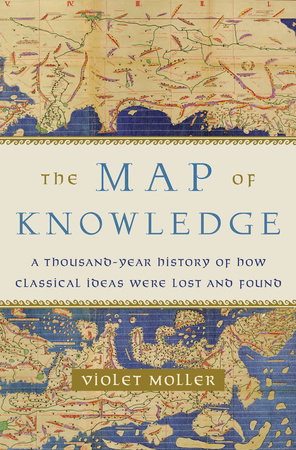Violet Moller - The Map of Knowledge
Violet Moller 2019. The Map of Knowledge. How classical ideas were lost and found: a history in seven cities. London: Penguin Random House, 331 pp.
Traces the story, also told in many other places, of how the knowledge of the early Greek scientists was preserved in the Islamic world during the century or so when conservative religion made such progressive thinking untenable in most of Europe. However, does so from a bibliophile’s perspective, tracing the works of Euclid, Galen and Ptolemy as they were sought, preserved and copied through the ancient (pre-1500) world. This different perspective is also a weakness because there is not very much focus on the content of the early works. Instead the author is more interested in the copyists and scholars. This seems to me a weakness in a book that purports to focus on science publishing.
The author tells a tale well although maybe with a few gratuitous adjectives. As it is there are embellished yarns of derring-do and high adventure, almost in Harry-Potter style as the protagonists escape pursuing armies and undertake risky sea voyages. A jolly fine yarn here and there. In Violet Moller’s view of history, this tale is told in turn from the streets and history of seven cities: first Alexandria and Baghdad, then Spain (Cordoba, Toledo) and finally Italy (Salerno, Palermo, Venice). A modern perspective is unfortunate in parts. For example, actions of some historical figures are related as if they somehow knew that the Dark Ages were coming.
I found myself lost in a little too much historical detail, especially in Spain, but the final chapter on Venice made it all worthwhile, very interesting. In this telling, Venice became an early adopter of Gutenberg’s press through entrepeneurship, political stability at a crucial time (the conservative monk Savanarola was causing an exodus of scholars from Florence), and timely connections between Nuremberg and Venice by astronomer Regiomantanus, scholar Bessarion and Venetian publishers Erhardt Ratdolt (expatriot German who published a new corrected edition of Euclid’s The Elements) and Aldus Manutius whose famous Aldine Press published among many others, the first complete works of Aristotle seen since antiquity. In Greek, however; he soon switched to Latin to keep the press afloat. In this final chapter it feels like the momentous events of emergence of publishing and rebirth of astronomy in Germany and their spread to Venice are treated in just a few short pages while earlier on several long chapters were devoted to Spain at a time when, from a science publishing perspective (the focus of this book, after all) not much was happening. I’ll be seeking some remedial reading to fill this gap.
Useful links:
- database of illustrations from books published before 1500
- ORBIS: The Stanford Geospatial Network Model of the Roman World
- In aedibus Aldi: the legacy of Aldus Manutius and his press
Selections for further reading from the bibliography:
- Ackroyd, Peter 2010. Venice: Pure City. London: Vintage.
- Cuomo, Serafina 2001. Ancient Mathematics. Oxford: One World.
- Eisenstein, Elisabeth L. 1980. The Printing Press as an Agent of Change. Cambridge: Cambridge University Press.
- Ferraro, Joanne M. 2012. Venice: History of the Floating City. Cambridge: Cambridge University Press.
- Folkerts, Menso 2006. The Development of Mathematics in Medieval Europe: The Arabs, Euclid, Regiomontanus. Aldershot: Ashgate Variorum.
- Greenblatt, Stephen 2011. The Swerve: How the Renaissance began. London: Bodley Head.
- al-Khalili, Jim 2010. The House of Wisdom: How Arabic Science Saved Ancient Knowledge and Gave Us the Renaissance. London: Penguin.
- Lowry, Martin 1979. The World of Aldus Manutius: Business and Scholarship in Renaissance Venice. Ithaca, New York: Cornell University Press.
- Ohler, Norbert 1989. The Medieval Traveller. Martlesham, Suffolk: Boydell Press.
- Rhodes, Neil & Sawday, Jonathan (eds) 2000. The Renaissance computer: knowledge technology in the first age of print. London: Routledge.



